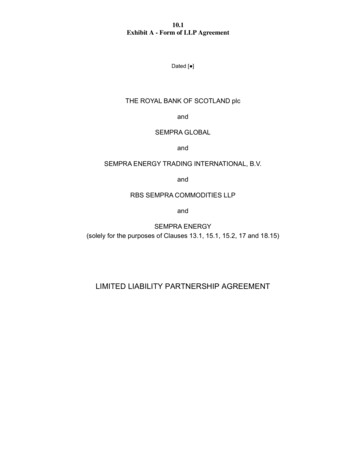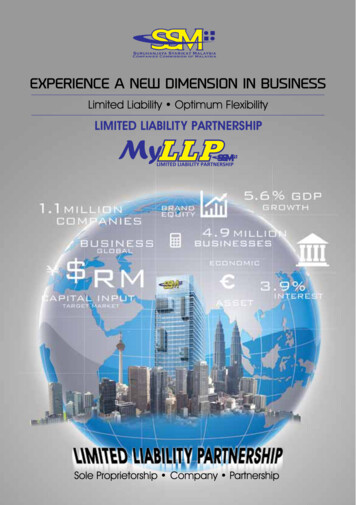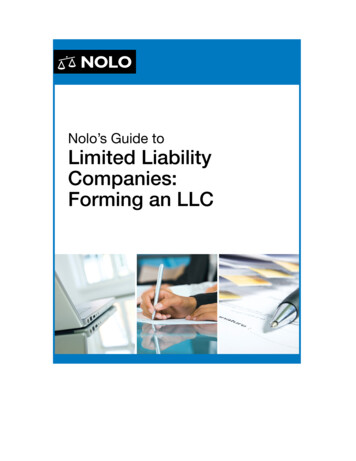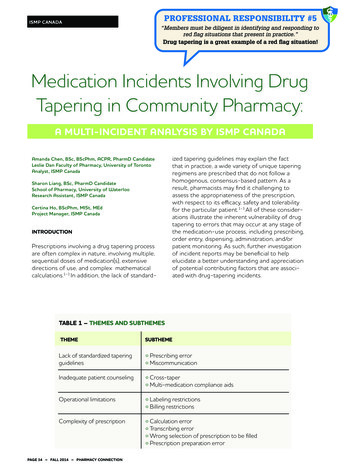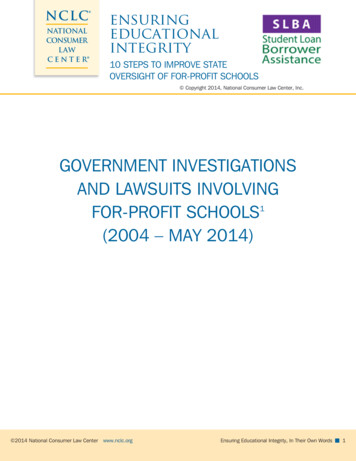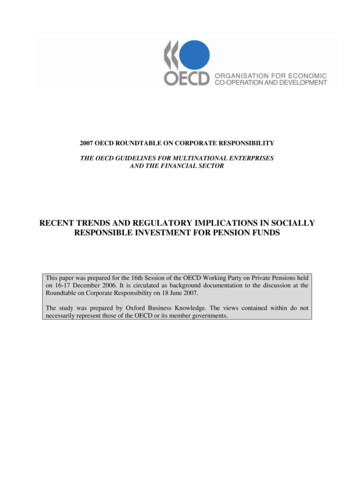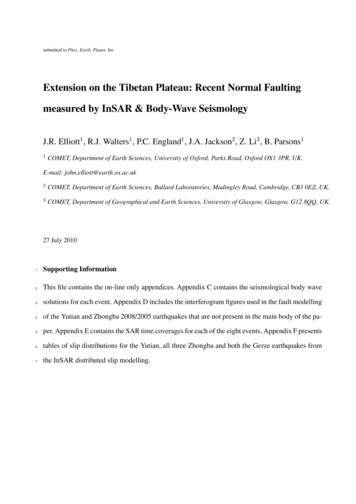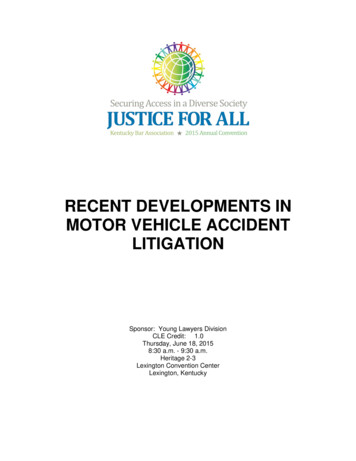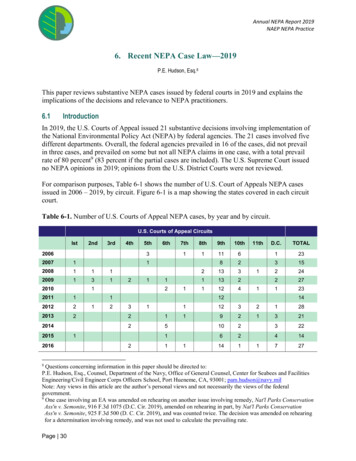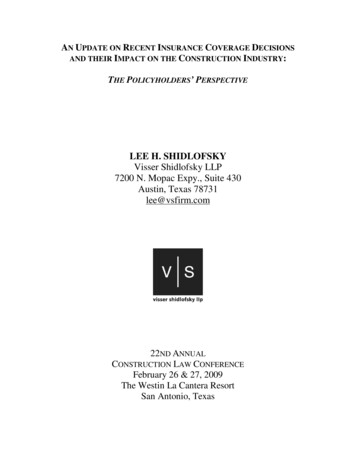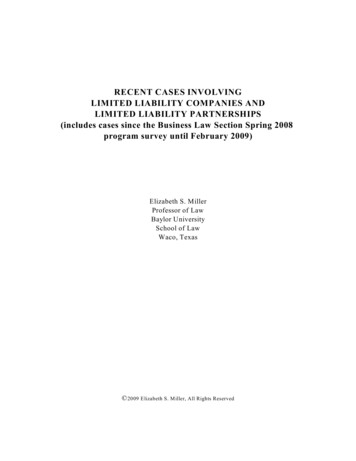
Transcription
RECENT CASES INVOLVINGLIMITED LIABILITY COMPANIES ANDLIMITED LIABILITY PARTNERSHIPS(includes cases since the Business Law Section Spring 2008program survey until February 2009)Elizabeth S. MillerProfessor of LawBaylor UniversitySchool of LawWaco, Texas 2009 Elizabeth S. Miller, All Rights Reserved
Table of ContentsPageI.LimitedA.B.C.D.E.F.G.Liability Partnerships. . . . . . . .Service of Process. . . . . . . . . .Venue. . . . . . . . . . . . . . . . . . .Pro Se Representation. . . . . . .Diversity Jurisdiction. . . . . . . .Limited Liability of Partners. .Bankruptcy. . . . . . . . . . . . . . .Securities Laws. . . . . . . . . . . ty Companies. . . . . . . . . . . . . . . . . . . . . . . . . . . . . . . . . . . . . . . . . . . . . . . . . . . . . . . . . . . . . 3Diversity Jurisdiction. . . . . . . . . . . . . . . . . . . . . . . . . . . . . . . . . . . . . . . . . . . . . . . . . . . . . . . . . . . . 3Personal Jurisdiction Over Members and Managers. . . . . . . . . . . . . . . . . . . . . . . . . . . . . . . . . . . . 4Service of Process. . . . . . . . . . . . . . . . . . . . . . . . . . . . . . . . . . . . . . . . . . . . . . . . . . . . . . . . . . . . . . 8Venue. . . . . . . . . . . . . . . . . . . . . . . . . . . . . . . . . . . . . . . . . . . . . . . . . . . . . . . . . . . . . . . . . . . . . . . 9Standing/Authority to Sue. . . . . . . . . . . . . . . . . . . . . . . . . . . . . . . . . . . . . . . . . . . . . . . . . . . . . . . 10Pro Se Representation. . . . . . . . . . . . . . . . . . . . . . . . . . . . . . . . . . . . . . . . . . . . . . . . . . . . . . . . . . 14Derivative Suits. . . . . . . . . . . . . . . . . . . . . . . . . . . . . . . . . . . . . . . . . . . . . . . . . . . . . . . . . . . . . . . 16Necessary Parties. . . . . . . . . . . . . . . . . . . . . . . . . . . . . . . . . . . . . . . . . . . . . . . . . . . . . . . . . . . . . . 22Scope of Discovery. . . . . . . . . . . . . . . . . . . . . . . . . . . . . . . . . . . . . . . . . . . . . . . . . . . . . . . . . . . . 22Arbitration. . . . . . . . . . . . . . . . . . . . . . . . . . . . . . . . . . . . . . . . . . . . . . . . . . . . . . . . . . . . . . . . . . . 23Stay of Proceedings. . . . . . . . . . . . . . . . . . . . . . . . . . . . . . . . . . . . . . . . . . . . . . . . . . . . . . . . . . . . 26Claim Preclusion. . . . . . . . . . . . . . . . . . . . . . . . . . . . . . . . . . . . . . . . . . . . . . . . . . . . . . . . . . . . . . 28Nature of LLC. . . . . . . . . . . . . . . . . . . . . . . . . . . . . . . . . . . . . . . . . . . . . . . . . . . . . . . . . . . . . . . . 28Formation of Failure to Form LLC. . . . . . . . . . . . . . . . . . . . . . . . . . . . . . . . . . . . . . . . . . . . . . . . 31Pre-Formation Transactions. . . . . . . . . . . . . . . . . . . . . . . . . . . . . . . . . . . . . . . . . . . . . . . . . . . . . 31Limited Liability of LLC Members and M anagers/Personal Liability Under Agency or OtherPrinciples. . . . . . . . . . . . . . . . . . . . . . . . . . . . . . . . . . . . . . . . . . . . . . . . . . . . . . . . . . . . . . . . . . . . 32LLC Veil Piercing. . . . . . . . . . . . . . . . . . . . . . . . . . . . . . . . . . . . . . . . . . . . . . . . . . . . . . . . . . . . . 40Authority of Members and Managers. . . . . . . . . . . . . . . . . . . . . . . . . . . . . . . . . . . . . . . . . . . . . . 49Admission of Members. . . . . . . . . . . . . . . . . . . . . . . . . . . . . . . . . . . . . . . . . . . . . . . . . . . . . . . . . 53LLC Property/Interest of Member. . . . . . . . . . . . . . . . . . . . . . . . . . . . . . . . . . . . . . . . . . . . . . . . . 56Fiduciary Duties of Members and Managers. . . . . . . . . . . . . . . . . . . . . . . . . . . . . . . . . . . . . . . . . 58Inspection and Access to Information. . . . . . . . . . . . . . . . . . . . . . . . . . . . . . . . . . . . . . . . . . . . . . 80Interpretation of Operating Agreement. . . . . . . . . . . . . . . . . . . . . . . . . . . . . . . . . . . . . . . . . . . . . 80Transfer of Interest/Buy-Out of Member. . . . . . . . . . . . . . . . . . . . . . . . . . . . . . . . . . . . . . . . . . . . 99Capital Contributions and Contribution Obligations. . . . . . . . . . . . . . . . . . . . . . . . . . . . . . . . . . 103Compensation of Member. . . . . . . . . . . . . . . . . . . . . . . . . . . . . . . . . . . . . . . . . . . . . . . . . . . . . . 105Improper Distributions. . . . . . . . . . . . . . . . . . . . . . . . . . . . . . . . . . . . . . . . . . . . . . . . . . . . . . . . 106W ithdrawal, Expulsion, or Termination of Member. . . . . . . . . . . . . . . . . . . . . . . . . . . . . . . . . . 107Dissolution and W inding Up. . . . . . . . . . . . . . . . . . . . . . . . . . . . . . . . . . . . . . . . . . . . . . . . . . . . 111Judicial or Administrative Dissolution. . . . . . . . . . . . . . . . . . . . . . . . . . . . . . . . . . . . . . . . . . . . 115Dissenter’s Rights. . . . . . . . . . . . . . . . . . . . . . . . . . . . . . . . . . . . . . . . . . . . . . . . . . . . . . . . . . . . 125Accounting. . . . . . . . . . . . . . . . . . . . . . . . . . . . . . . . . . . . . . . . . . . . . . . . . . . . . . . . . . . . . . . . . 126Professional LLCs. . . . . . . . . . . . . . . . . . . . . . . . . . . . . . . . . . . . . . . . . . . . . . . . . . . . . . . . . . . . 127Foreign LLC - Failure to Qualify to Do Business. . . . . . . . . . . . . . . . . . . . . . . . . . . . . . . . . . . . 128Foreign LLCs - Constitutionality of Fee or Tax. . . . . . . . . . . . . . . . . . . . . . . . . . . . . . . . . . . . . 129Foreign LLC – Governing Law. . . . . . . . . . . . . . . . . . . . . . . . . . . . . . . . . . . . . . . . . . . . . . . . . . 129Charging Order. . . . . . . . . . . . . . . . . . . . . . . . . . . . . . . . . . . . . . . . . . . . . . . . . . . . . . . . . . . . . . JJ.KK.ii.11111123
BB.CCC.DDD.EEE.FFF.GGG.HHH.Divorce of Member. . . . . . . . . . . . . . . . . . . . . . . . . . . . . . . . . . . . . . . . . . . . . . . . . . . . . . . . . . .Receivership. . . . . . . . . . . . . . . . . . . . . . . . . . . . . . . . . . . . . . . . . . . . . . . . . . . . . . . . . . . . . . . .Bankruptcy. . . . . . . . . . . . . . . . . . . . . . . . . . . . . . . . . . . . . . . . . . . . . . . . . . . . . . . . . . . . . . . . .Fraudulent Transfer. . . . . . . . . . . . . . . . . . . . . . . . . . . . . . . . . . . . . . . . . . . . . . . . . . . . . . . . . . .Creditor’s Rights. . . . . . . . . . . . . . . . . . . . . . . . . . . . . . . . . . . . . . . . . . . . . . . . . . . . . . . . . . . . .Secured Transactions. . . . . . . . . . . . . . . . . . . . . . . . . . . . . . . . . . . . . . . . . . . . . . . . . . . . . . . . . .Securities Laws. . . . . . . . . . . . . . . . . . . . . . . . . . . . . . . . . . . . . . . . . . . . . . . . . . . . . . . . . . . . . .W orker’s Compensation. . . . . . . . . . . . . . . . . . . . . . . . . . . . . . . . . . . . . . . . . . . . . . . . . . . . . . .State and Local Taxes. . . . . . . . . . . . . . . . . . . . . . . . . . . . . . . . . . . . . . . . . . . . . . . . . . . . . . . . .Medicaid Eligibility and LLC Property. . . . . . . . . . . . . . . . . . . . . . . . . . . . . . . . . . . . . . . . . . . .Unfair Business Practices Statutes. . . . . . . . . . . . . . . . . . . . . . . . . . . . . . . . . . . . . . . . . . . . . . . .W age and Employment Statutes. . . . . . . . . . . . . . . . . . . . . . . . . . . . . . . . . . . . . . . . . . . . . . . . .Insurance. . . . . . . . . . . . . . . . . . . . . . . . . . . . . . . . . . . . . . . . . . . . . . . . . . . . . . . . . . . . . . . . . . .Statute of Frauds. . . . . . . . . . . . . . . . . . . . . . . . . . . . . . . . . . . . . . . . . . . . . . . . . . . . . . . . . . . . .Equitable Contribution. . . . . . . . . . . . . . . . . . . . . . . . . . . . . . . . . . . . . . . . . . . . . . . . . . . . . . . .Tortious Interference. . . . . . . . . . . . . . . . . . . . . . . . . . . . . . . . . . . . . . . . . . . . . . . . . . . . . . . . . .Intracorporate Conspiracy. . . . . . . . . . . . . . . . . . . . . . . . . . . . . . . . . . . . . . . . . . . . . . . . . . . . . .Successor Liability. . . . . . . . . . . . . . . . . . . . . . . . . . . . . . . . . . . . . . . . . . . . . . . . . . . . . . . . . . .Conversion, Merger, Reorganization. . . . . . . . . . . . . . . . . . . . . . . . . . . . . . . . . . . . . . . . . . . . . .Single Member’s Employment Tax Liability /Validity of Check-the-Box Regulations. . . . . . .LLC Payments as W ages or Salary Subject to IRS Levy. . . . . . . . . . . . . . . . . . . . . . . . . . . . . .Attorney Liability, Disqualification. . . . . . . . . . . . . . . . . . . . . . . . . . . . . . . . . . . . . . . . . . . . . . .Attorney Client Privilege. . . . . . . . . . . . . . . . . . . . . . . . . . . . . . . . . . . . . . . . . . . . . . . . . . . . . . 50151151151154154155157
RECENT CASES INVOLVINGLIM ITED LIABILITY COM PANIES ANDLIM ITED LIABILITY PARTNERSHIPSBy Elizabeth S. MillerFebruary, 2009This paper summarizes cases, as of February, 2009, that have appeared since the paper prepared for thePartnerships and LLCs: Important Case Law Developments– 2008 program presented at the Spring Meeting of theBusiness Law Section of the ABA. Additional surveys of LLP and LLC cases may be accessed at the Baylor Law Schoolweb site at http://law.baylor.edu.I.Limited Liability PartnershipsA.Service of ProcessPDM Steel Service Centers, Inc. v. Mullen & Filippi, No. F054031 (Cal. App. 5 th Dist. Aug. 8, 2008). Theplaintiff attempted service of process on a California LLP by serving an office employee of the LLP. The individual wasnot the registered agent identified in the LLP’s registration statement, and the plaintiff failed to establish that theindividual had ostensible authority to accept service of process for the LLP. Therefore, the plaintiff did not comply withthe procedures required for service of process on an LLP.B.VenueEx parte Burr & Form an, LLP, So.2d , 2008 W L 4182829 (Ala. 2008) (pointing out that fact partnershipis LLP does not change its treatment for venue purposes because partnership that registers as LLP is same entity thatexisted before registration and continues to be partnership under Alabama law subject to LLP provisions of partnershipstatute).C.Pro Se RepresentationMarin v. Gilberg, Civil Action No. V-07-62, 2008 W L 2770382 (S.D. Tex. July 11, 2008) (LLP may not appearpro se).D.Diversity JurisdictionMorgan, Lewis & Bockius LLP v. City of East Chicago, No. 08 C 2748, 2008 W L 4812658 (N.D. Ill. Oct.29, 2008) (applying rule that citizenship of LLP is determined by citizenship of all its partners and thus “stateless”partner (U.S. citizen domiciled in United Kingdom) destroyed diversity jurisdiction).ZF Lem forder Corporation v Rochling Autom otive Duncan, L.L.P., C.A. No. 7:8-3436-HM H, 2008 W L4831470 (D.S.C. Nov. 3, 2008) (dismissing for lack of subject matter jurisdiction based on rule that citizenship of LLPis determined by citizenship of all its partners).E.Limited Liability of PartnersiCore Networks, Inc. v. McQuade Brennan LLP, No. 1:08CV748(JCC), 2009 W L 36596 (E.D. Va. Jan. 5,2009). A partner of a District of Columbia LLP accounting firm moved to dismiss professional malpractice and breachof fiduciary duty claims against him in his individual capacity. In an earlier opinion, the court found that the plaintiffhad not sufficiently alleged an individual duty separate and apart from the duty of the LLP, and the partner was protectedfrom vicarious liability by the D.C. LLP statute. The main issue addressed by the court in this opinion was whether theplaintiff’s amended complaint alleged a duty on the part of the partner that would allow him to be liable in his individualcapacity. The court found that it did. The plaintiff was suing the firm for embezzling funds from the plaintiff by1
overcharging for services, charging for unperformed services, and forging and cashing checks. To conceal theembezzlement, an individual or individuals at the firm created false invoices and made alterations of the plaintiff’s booksand records. The firm alleged that one individual carried out the scheme acting alone; however, the plaintiff sought tohold one of the partners, McQuade, personally liable. The court reviewed the amended allegations and found that,liberally construed, they alleged a duty on the part of McQuade in his individual capacity. The complaint stated thatMcQuade reviewed the work done by the alleged embezzler and assured the plaintiff that the work had been doneproperly. The alleged assurances were given at a time when the firm was negotiating a long-term accounting servicescontract with the plaintiff. The court stated that it may have been reasonable for McQuade to assume that the long-termengagement depended upon the outcome of the check reconciliations and assurances provided by McQuade. Thus, therewas a plausible claim that McQuade’s actions violated a duty of reasonable care and led, in whole or in part, to thedamages suffered by the plaintiff. The claim for professional malpractice thus survived. The court noted that courts donot generally regard the accountant-client relationship as a fiduciary one, but concluded that the allegations supporteda breach of fiduciary duty claim as well.iCore Networks, Inc. v. McQuade Brennan LLP, No. 1:08cv748 (JCC), 2008 W L 4550988 (E.D. Va. Oct.7, 2008) (noting limited liability of partner in LLP and holding conclusory allegation that partner “assumedresponsibility” for LLP accounting firm’s performance was insufficient to allege individual duty by partner to client).Santos v. 304 West 56 th Street Realty LLC, 862 N.Y.S.2d 435 (N.Y. Sup. 2008) (stating complaint must bedismissed as to general partner of defendant LLP in negligence action since partner of partnership which is LLP is notliable for liabilities of LLP).Red River Wings, Inc. v. Hoot, Inc., 751 N.W .2d 206 (N.D. 2008). Two individuals who were partners in anLLP that was a limited partner in limited partnerships that owned franchised restaurants were held liable for the LLP’sbreach of fiduciary duty as a limited partner in connection with seizing control of the limited partnerships and oustingthe general partner. The court relied upon the veil piercing provision of the North Dakota LLP statute which states thatprinciples of corporate veil piercing apply to LLPs. The court stated that the evidence of the participation of the LLPpartners in the takeover of the limited partnership in which the LLP was a limited partner supported the trial court’simplicit finding that it would be inequitable if the LLP partners’ acts were treated as those of the LLP alone and that thetrial court did not err in holding the partners of the LLP liable.Kuslansky v. Kuslansky, Robbins, Stechel, and Cunningham, LLP, 858 N.Y.S.2d 213 (N.Y.A.D. 2 Dept.2008). A withdrawn partner sought to recover payment from the remaining partners for the value of his partnershipinterest under the partnership agreement. The defendant partners argued that they were shielded from liability by theNew York LLP provisions, but the court pointed out that the New York Court of Appeals held in Ederer v. Gursky thatthe LLP liability shield only applies to a partner’s liability to third parties and does not shield a general partner in an LLPfrom breaches of the partnership’s or partner’s obligations to each other.F.BankruptcyIn re Ram bo Im aging, L.L.P., No. 07-11190-FRM, 2008 W L 2778846 (Bankr. W .D. Tex. July 15, 2008).The issue in this case was whether an individual who was a partner of a Texas LLP was a general partner with standingto be a petitioner in an involuntary bankruptcy case. The partnership was a general partnership registered under theTexas full shield LLP statute. The court stated that it had been unable to find any case law addressing the ability of apartner in an LLP to file an involuntary action, and the court relied upon Collier on Bankruptcy in concluding that thepetitioning general partner should be treated as a shareholder of a corporation under the Bankruptcy Code and thusineligible to be a petitioning partner under Section 303(b)(3). Collier on Bankruptcy takes the position that a full shieldLLP should be treated as a corporation because the definition of a “corporation” under the Bankruptcy Code broadlyencompasses a “partnership association organized under a law that makes only the capital subscribed responsible for thedebts of the association” and because, in view of the purpose of Section 303(b)(3), which is to protect general partnerswho are exposed to personal liability for partnership obligations, it makes sense that Section 303(b)(3) should not beavailable to LLP partners. The court went on to conclude that, even if the petitioning individual was a general partner,he should be estopped to make that claim because it was clearly inconsistent with the individual’s position in prior2
litigation in which he claimed to be a limited partner. The court stated that the individual’s view of what type of partnerhe was seemed to change as his perceived interest changed, and that is precisely the situation judicial estoppel wasdesigned to address.G.Securities LawsSecurities and Exchange Comm ission v. Merchant Capital, LLC, 311 Fed.Appx. 250, 2009 W L 294751 (11 thCir. 2009). In a prior opinion, the court of appeals concluded that the LLP interests in 28 LLPs were investmentcontracts subject to federal securities laws. The court in the prior opinion remanded the case to the district court for afinding of whether the defendants had acted with scienter or negligently with respect to certain material omissions. Thecourt of appeals instructed the district court to consider numerous matters, including whether the defendants had anybusiness reason, apart from evading the securities laws, for employing a sham balloting procedure and adopting abusiness form that divided the investors into 28 separate partnerships when they intended to pool the money. On remand,the district court, on the same record from the prior appeal, simply found that there was no scienter because, in its view,the omissions were made in good faith. The court of appeals stated that it was clear from the record that the omissionswere committed negligently or with scienter, and the court remanded to the district court once again with instructionsthat it was not at liberty to find that the omissions were made neither with scienter or negligently. The court also orderedthe district court to enter judgment for the SEC on the strict liability violations of the registration provisions.II.Limited Liability CompaniesA.Diversity JurisdictionFederal courts of appeals and district courts continue to hold that an LLC has the citizenship of each of itsmembers for diversity jurisdiction purposes. The district court opinions to this effect are too numerous to list. A fewdistrict court opinions raising issues of particular interest are noted below. Recent opinions in which circuit courts ofappeals have applied or recognized the rule that an LLC’s citizenship is determined by that of all its members includeHarvey v. Grey Wolf Drilling Co., 542 F.3d 1077 (5 th Cir. 2008) and Metalm ark Northwest, LLC v. Stewart, No. 0635321, 2008 W L 361039 (9 th Cir. Feb.
ZF Lemforder Corporation v Rochling Automotive Duncan, L.L.P., C.A. No. 7:8-3436-HMH, 2008 WL 4831470 ( D.S.C. Nov. 3, 2008) (dismissing for lack of subject matter jurisdiction based on rule that citizenship of LLP is determined by citizensh
